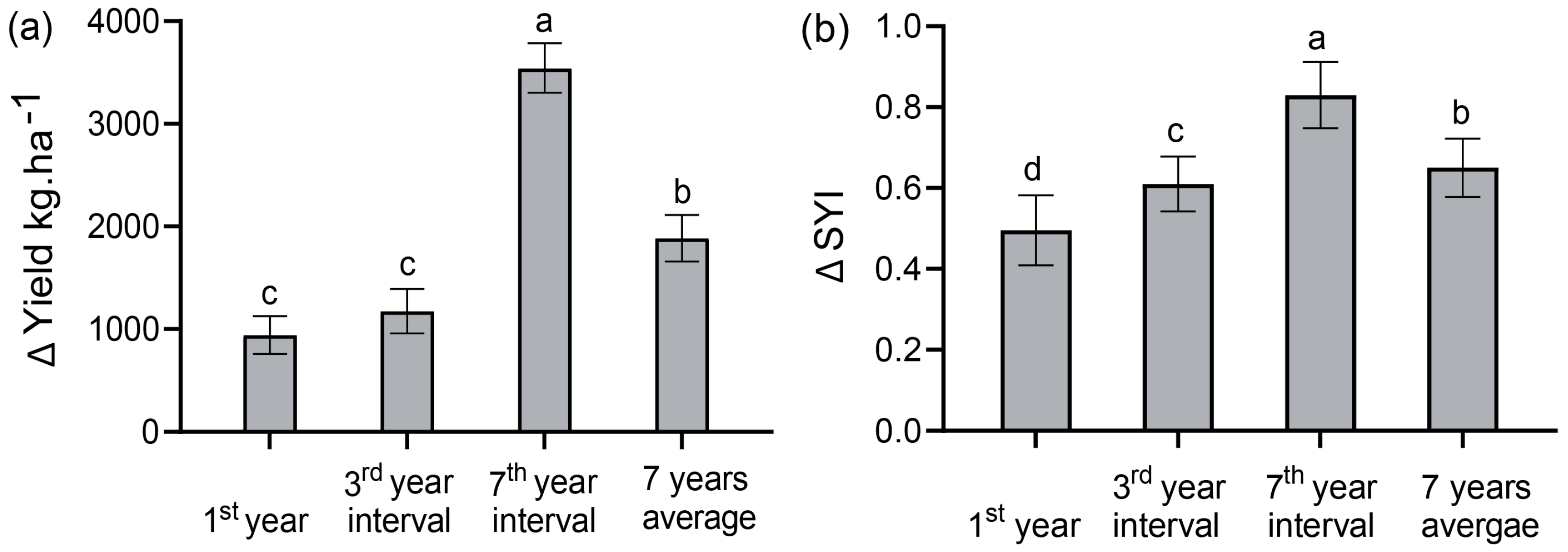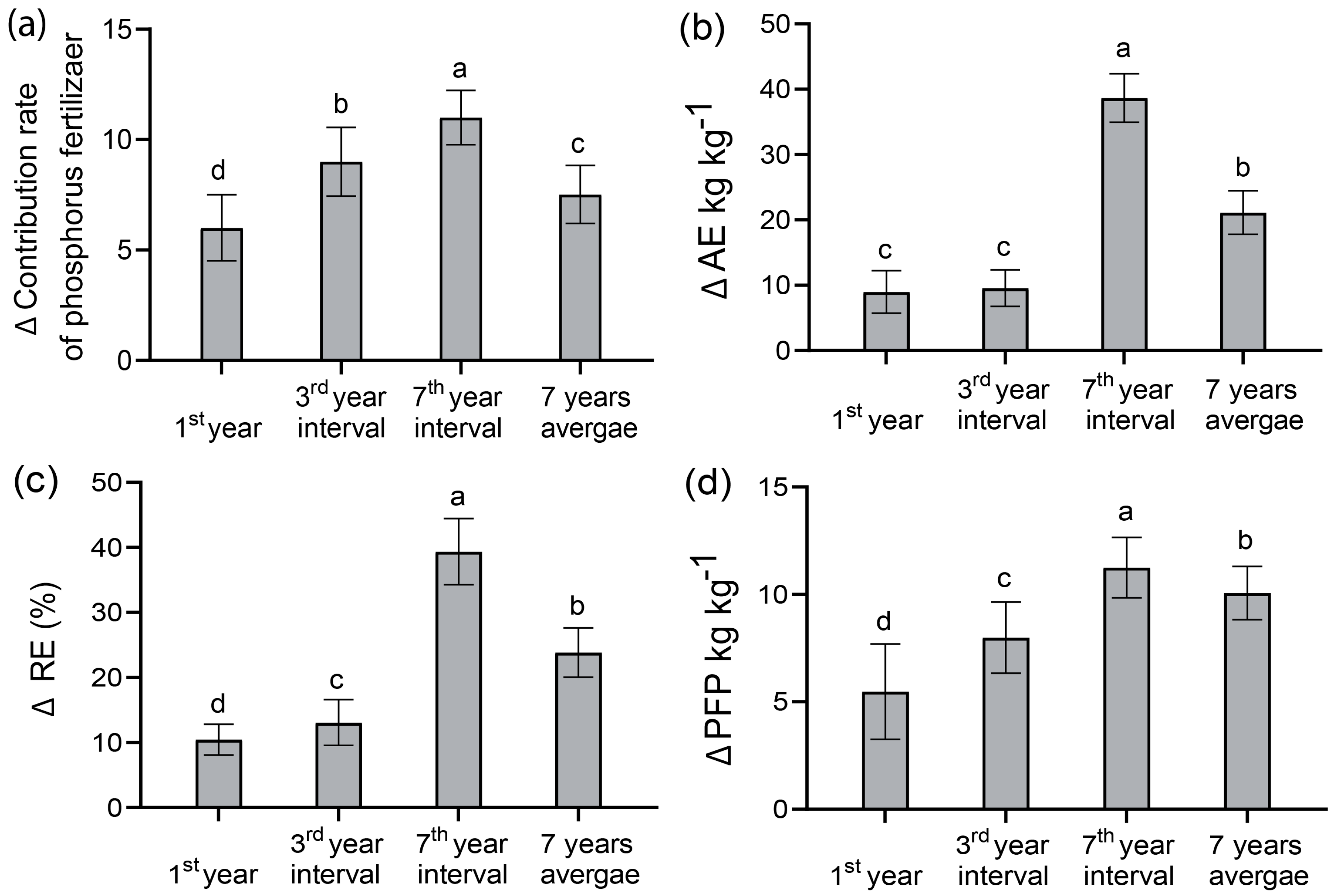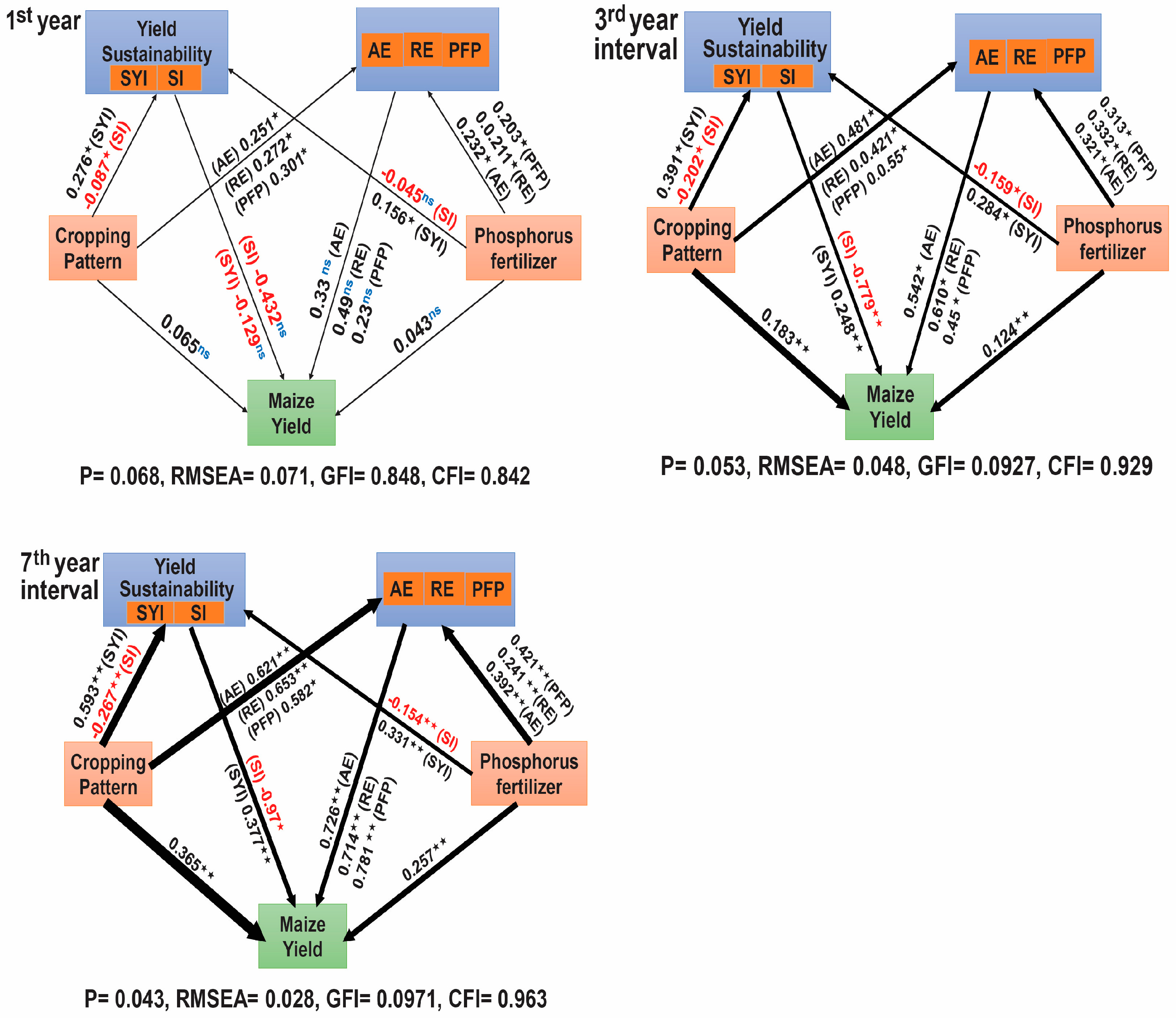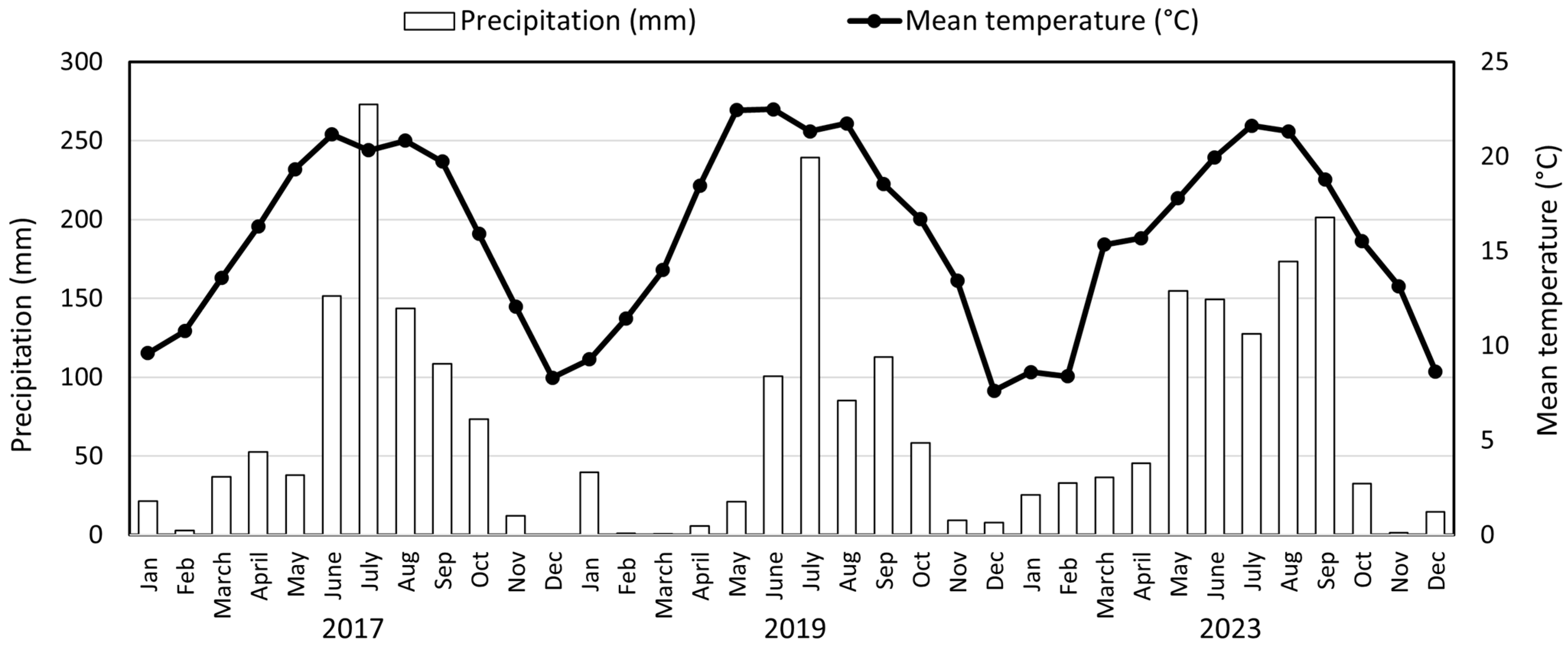Long-Term Year-Interval Effect of Continuous Maize/Soybean Intercropping on Maize Yield and Phosphorus Use Efficiency
Abstract
1. Introduction
2. Results
2.1. The Year-Interval Effects on Maize Yield and Yield Sustainability Under Maize/Soybean Continuous Intercropping
2.1.1. The Year-Interval Effects on Yield and Sustainability
2.1.2. The Year-Interval Effects on Actual Yield Loss and Yield Stability
2.2. The Year-Interval Effects on Phosphorus Use Efficiency Under Maize/Soybean Continuous Intercropping
2.2.1. The Year-Interval Effects on the Contribution of Phosphate Fertilizer
2.2.2. The Year-Interval Effects on the Phosphate Use Efficiency
2.3. Structural Equation Model Analysis of the Year-Interval Effects Under Maize/Soybean Continuous Intercropping
3. Discussion
3.1. Maize Yield and Yield Sustainability Affected by Year Intervals Under Continuous Intercropping
3.2. Actual Yield Loss and Yield Stability Affected by Year Intervals Under Continuous Intercropping
3.3. Phosphorus Fertilizer Contribution and Phosphorus Use Efficiency Affected by Year Intervals of Continuous Intercropping
4. Materials and Methods
4.1. Experimental Design and Agronomic Management
4.2. Sample Collection
4.3. Yield Indices Calculation
4.3.1. Maize Grain Yield and Sustainable Yield Index
4.3.2. Actual Yield Loss and Maize Yield Stability
4.3.3. The Contributions of P Fertilizer (CPF), Agronomic Efficiency (AE), the Apparent Recovery Rate of Phosphate Fertilizer (RE), and the Partial Productivity of Phosphate Fertilizer (PFPP)
4.4. Statistical Analysis
5. Conclusions
Author Contributions
Funding
Data Availability Statement
Conflicts of Interest
References
- Renard, D.; Tilman, D. National food production stabilized by crop diversity. Nature 2019, 571, 257–260. [Google Scholar] [CrossRef] [PubMed]
- Knapp, S.; van der Heijden, M.G. A global meta-analysis of yield stability in organic and conservation agriculture. Nat. Commun. 2018, 9, 3632. [Google Scholar] [CrossRef]
- Alhammad, B.A.; Roy, D.K.; Ranjan, S.; Padhan, S.R.; Sow, S.; Nath, D.; Seleiman, M.F.; Gitari, H. Conservation tillage and weed management influencing weed dynamics, crop performance, soil properties, and profitability in a rice–wheat–greengram system in the eastern Indo-Gangetic plain. Agronomy 2023, 13, 1953. [Google Scholar] [CrossRef]
- Bi, Y.; Zhou, P.; Li, S.; Wei, Y.; Xiong, X.; Shi, Y.; Liu, N.; Zhang, Y. Interspecific interactions contribute to higher forage yield and are affected by phosphorus application in a fully-mixed perennial legume and grass intercropping system. Field Crops Res. 2019, 244, 107636. [Google Scholar] [CrossRef]
- Bouwman, A.; Beusen, A.; Lassaletta, L.; Van Apeldoorn, D.; Van Grinsven, H.; Zhang, J.; Ittersum Van, M. Lessons from temporal and spatial patterns in global use of N and P fertilizer on cropland. Sci. Rep. 2017, 7, 40366. [Google Scholar] [CrossRef]
- Brownlie, W.J.; Sutton, M.A.; Heal, K.V.; Reay, D.S.; Spears, B. Our Phosphorus Future: Towards Global Phosphorus Sustainability; UK Centre for Ecology & Hydrology: Edinburgh, UK, 2022. [Google Scholar]
- Zhang, L.-Z.; Van der Werf, W.; Bastiaans, L.; Zhang, S.; Li, B.; Spiertz, J. Light interception and utilization in relay intercrops of wheat and cotton. Field Crops Res. 2008, 107, 29–42. [Google Scholar] [CrossRef]
- Chamkhi, I.; Cheto, S.; Geistlinger, J.; Zeroual, Y.; Kouisni, L.; Bargaz, A.; Ghoulam, C. Legume-based intercropping systems promote beneficial rhizobacterial community and crop yield under stressing conditions. Ind. Crops Prod. 2022, 183, 114958. [Google Scholar]
- Marcillo, G.; Miguez, F. Corn yield response to winter cover crops: An updated meta-analysis. J. Soil Water Conserv. 2017, 72, 226–239. [Google Scholar]
- Maitra, S.; Sairam, M.; Ray, S.; Santosh, D.; Gaikwad, D.J.; Gitari, H.I.; Mukesh, G.; Maheswari, N. Applauding soil quality improvement through legume-based intercropping system: A Review. Int. J. Dent. Med. Spec. 2024, 11, 59–69. [Google Scholar]
- Raza, M.A.; Zhiqi, W.; Yasin, H.S.; Gul, H.; Qin, R.; Rehman, S.U.; Mahmood, A.; Iqbal, Z.; Ahmed, Z.; Luo, S. Effect of crop combination on yield performance, nutrient uptake, and land use advantage of cereal/legume intercropping systems. Field Crops Res. 2023, 304, 109144. [Google Scholar] [CrossRef]
- Snapp, S.S.; Blackie, M.J.; Gilbert, R.A.; Bezner-Kerr, R.; Kanyama-Phiri, G.Y. Biodiversity can support a greener revolution in Africa. Proc. Natl. Acad. Sci. USA 2010, 107, 20840–20845. [Google Scholar] [CrossRef] [PubMed]
- Brooker, R.W.; Bennett, A.E.; Cong, W.F.; Daniell, T.J.; George, T.S.; Hallett, P.D.; Hawes, C.; Iannetta, P.P.; Jones, H.G.; Karley, A.J. Improving intercropping: A synthesis of research in agronomy, plant physiology and ecology. New Phytol. 2015, 206, 107–117. [Google Scholar] [PubMed]
- Li, X.-F.; Wang, Z.-G.; Bao, X.-G.; Sun, J.-H.; Yang, S.-C.; Wang, P.; Wang, C.-B.; Wu, J.-P.; Liu, X.-R.; Tian, X.-L. Long-term increased grain yield and soil fertility from intercropping. Nat. Sustain. 2021, 4, 943–950. [Google Scholar] [CrossRef]
- Zhou, L.; Su, L.; Zhao, H.; Wang, S.; Zheng, Y.; Tang, L. Maize/soybean intercropping promoted activation of soil organic phosphorus fractions by enhancing more phosphatase activity in red soil under different phosphorus application rates. Plant Soil 2025, 506, 421–440. [Google Scholar] [CrossRef]
- Dong, N.; Tang, M.-M.; Zhang, W.-P.; Bao, X.-G.; Wang, Y.; Christie, P.; Li, L. Temporal differentiation of crop growth as one of the drivers of intercropping yield advantage. Sci. Rep. 2018, 8, 3110. [Google Scholar] [CrossRef]
- Li, C.; Hoffland, E.; Kuyper, T.W.; Yu, Y.; Li, H.; Zhang, C.; Zhang, F.; van der Werf, W. Yield gain, complementarity and competitive dominance in intercropping in China: A meta-analysis of drivers of yield gain using additive partitioning. Eur. J. Agron. 2020, 113, 125987. [Google Scholar] [CrossRef]
- Li, L.; Li, S.-M.; Sun, J.-H.; Zhou, L.-L.; Bao, X.-G.; Zhang, H.-G.; Zhang, F.-S. Diversity enhances agricultural productivity via rhizosphere phosphorus facilitation on phosphorus-deficient soils. Proc. Natl. Acad. Sci. USA 2007, 104, 11192–11196. [Google Scholar]
- Nasar, J.; Ahmad, M.; Gitari, H.; Tang, L.; Chen, Y.; Zhou, X.-B. Maize/soybean intercropping increases nutrient uptake, crop yield and modifies soil physio-chemical characteristics and enzymatic activities in the subtropical humid region based in Southwest China. BMC Plant Biol. 2024, 24, 434. [Google Scholar]
- Yu, Y.; Stomph, T.-J.; Makowski, D.; van Der Werf, W. Temporal niche differentiation increases the land equivalent ratio of annual intercrops: A meta-analysis. Field Crops Res. 2015, 184, 133–144. [Google Scholar] [CrossRef]
- Cong, W.F.; Hoffland, E.; Li, L.; Six, J.; Sun, J.H.; Bao, X.G.; Zhang, F.S.; Van Der Werf, W. Intercropping enhances soil carbon and nitrogen. Glob. Change Biol. 2015, 21, 1715–1726. [Google Scholar]
- Wang, L.; Hou, B.; Zhang, D.; Lyu, Y.; Zhang, K.; Li, H.; Rengel, Z.; Shen, J. The niche complementarity driven by rhizosphere interactions enhances phosphorus-use efficiency in maize/alfalfa mixture. Food Energy Secur. 2020, 9, e252. [Google Scholar]
- Mei, P.-P.; Gui, L.-G.; Wang, P.; Huang, J.-C.; Long, H.-Y.; Christie, P.; Li, L. Maize/faba bean intercropping with rhizobia inoculation enhances productivity and recovery of fertilizer P in a reclaimed desert soil. Field Crops Res. 2012, 130, 19–27. [Google Scholar] [CrossRef]
- Xia, H.-Y.; Wang, Z.-G.; Zhao, J.-H.; Sun, J.-H.; Bao, X.-G.; Christie, P.; Zhang, F.-S.; Li, L. Contribution of interspecific interactions and phosphorus application to sustainable and productive intercropping systems. Field Crops Res. 2013, 154, 53–64. [Google Scholar] [CrossRef]
- Wang, X.; Deng, X.; Pu, T.; Song, C.; Yong, T.; Yang, F.; Sun, X.; Liu, W.; Yan, Y.; Du, J. Contribution of interspecific interactions and phosphorus application to increasing soil phosphorus availability in relay intercropping systems. Field Crops Res. 2017, 204, 12–22. [Google Scholar]
- Ma, X.; Wang, T.; Lu, L.; Huang, H.; Ding, J.; Zhang, F. Developing a 3D clumping index model to improve optical measurement accuracy of crop leaf area index. Field Crops Res. 2022, 275, 108361. [Google Scholar]
- Gitari, H.I.; Shadrack, N.; Kamau, S.; Karanja, N.N.; Gachene, C.K.; Schulte-Geldermann, E. Agronomic assessment of phosphorus efficacy for potato (Solanum tuberosum L) under legume intercrops. J. Plant Nutr. 2020, 43, 864–878. [Google Scholar]
- Ma, H.; Yu, X.; Yu, Q.; Wu, H.; Zhang, H.; Pang, J.; Gao, Y. Maize/alfalfa intercropping enhances yield and phosphorus acquisition. Field Crops Res. 2023, 303, 109136. [Google Scholar]
- Raza, M.A.; Gul, H.; Wang, J.; Yasin, H.S.; Qin, R.; Khalid, M.H.B.; Naeem, M.; Feng, L.Y.; Iqbal, N.; Gitari, H. Land productivity and water use efficiency of maize-soybean strip intercropping systems in semi-arid areas: A case study in Punjab Province, Pakistan. J. Clean. Prod. 2021, 308, 127282. [Google Scholar]
- Su, L.; Zhao, H.; Hou, X.; Chen, Y.; Xiao, J.; Zheng, Y.; Tang, L. Activation of phosphorus pools in red soil by maize and soybean intercropping and its response to phosphorus fertilizer. Chin. J. Eco-Agric. 2023, 31, 558–566. [Google Scholar]
- Xu, Z.; Li, C.; Zhang, C.; Yu, Y.; van der Werf, W.; Zhang, F. Intercropping maize and soybean increases efficiency of land and fertilizer nitrogen use; A meta-analysis. Field Crops Res. 2020, 246, 107661. [Google Scholar] [CrossRef]
- Yu, Y.; Stomph, T.-J.; Makowski, D.; Zhang, L.; Van Der Werf, W. A meta-analysis of relative crop yields in cereal/legume mixtures suggests options for management. Field Crops Res. 2016, 198, 269–279. [Google Scholar] [CrossRef]
- Wang, W.; Li, M.-Y.; Gong, D.-S.; Zhou, R.; Khan, A.; Zhu, Y.; Zhu, H.; Abrar, M.; Zhu, S.-G.; Wang, B.-Z. Water use of intercropped species: Maize-soybean, soybean-wheat and wheat-maize. Agric. Water Manag. 2022, 269, 107690. [Google Scholar] [CrossRef]
- Jiang, P.; Wang, Y.; Zhang, Y.; Fei, J.; Rong, X.; Peng, J.; Yin, L.; Luo, G. Intercropping enhances maize growth and nutrient uptake by driving the link between rhizosphere metabolites and microbiomes. New Phytol. 2024, 243, 1506–1521. [Google Scholar] [CrossRef] [PubMed]
- Lu, M.; Zhao, J.; Lu, Z.; Li, M.; Yang, J.; Fullen, M.; Li, Y.; Fan, M. Maize–soybean intercropping increases soil nutrient availability and aggregate stability. Plant Soil 2025, 506, 441–456. [Google Scholar] [CrossRef]
- Yang, Z.; Zhang, Y.; Wang, Y.; Zhang, H.; Zhu, Q.; Yan, B.; Fei, J.; Xiangmin, R.; Peng, J.; Luo, G. Intercropping regulation of soil phosphorus composition and microbially-driven dynamics facilitates maize phosphorus uptake and productivity improvement. Field Crops Res. 2022, 287, 108666. [Google Scholar] [CrossRef]
- Wang, Y.; Zhang, Y.; Zhang, H.; Yang, Z.; Zhu, Q.; Yan, B.; Fei, J.; Rong, X.; Peng, J.; Luo, G. Intercropping-driven nitrogen trade-off enhances maize productivity in a long-term experiment. Field Crops Res. 2022, 287, 108671. [Google Scholar] [CrossRef]
- Zhang, S.; Meng, L.; Hou, J.; Liu, X.; Ogundeji, A.O.; Cheng, Z.; Yin, T.; Clarke, N.; Hu, B.; Li, S. Maize/soybean intercropping improves stability of soil aggregates driven by arbuscular mycorrhizal fungi in a black soil of northeast China. Plant Soil 2022, 481, 63–82. [Google Scholar] [CrossRef]
- He, J.; He, J.; Li, H.; Yu, Y.; Qian, L.; Tang, L.; Zheng, Y.; Xiao, J. Continuous Intercropping Increases the Depletion of Soil Available and Non-Labile Phosphorus. Agronomy 2024, 14, 1121. [Google Scholar] [CrossRef]
- Raseduzzaman, M.; Jensen, E.S. Does intercropping enhance yield stability in arable crop production? A meta-analysis. Eur. J. Agron. 2017, 91, 25–33. [Google Scholar] [CrossRef]
- Raza, M.A.; Cui, L.; Qin, R.; Yang, F.; Yang, W. Strip-width determines competitive strengths and grain yields of intercrop species in relay intercropping system. Sci. Rep. 2020, 10, 21910. [Google Scholar] [CrossRef]
- Nasar, J.; Wang, G.Y.; Zhou, F.J.; Gitari, H.; Zhou, X.B.; Tabl, K.M.; Hasan, M.E.; Ali, H.; Waqas, M.M.; Ali, I. Nitrogen fertilization coupled with foliar application of iron and molybdenum improves shade tolerance of soybean under maize-soybean intercropping. Front. Plant Sci. 2022, 13, 1014640. [Google Scholar]
- Yang, S.; Zhao, Y.; Xu, Y.; Cui, J.; Li, T.; Hu, Y.; Qian, X.; Li, Z.; Sui, P.; Chen, Y. Yield performance response to field configuration of maize and soybean intercropping in China: A meta-analysis. Field Crops Res. 2024, 306, 109235. [Google Scholar]
- Huang, J.; Xie, W. China’s Further Food Supply and Demand: Prospects and Policies. Front. Sci. Technol. Eng. Manag. 2022, 41, 17–25. [Google Scholar]
- Liu, X.; Meng, L.; Yin, T.; Wang, X.; Zhang, S.; Cheng, Z.; Ogundeji, A.O.; Li, S. Maize/soybean intercrop over time has higher yield stability relative to matched monoculture under different nitrogen-application rates. Field Crops Res. 2023, 301, 109015. [Google Scholar]
- Nasar, J.; Khan, W.; Khan, M.Z.; Gitari, H.I.; Gbolayori, J.F.; Moussa, A.A.; Mandozai, A.; Rizwan, N.; Anwari, G.; Maroof, S.M. Photosynthetic activities and photosynthetic nitrogen use efficiency of maize crop under different planting patterns and nitrogen fertilization. J. Soil Sci. Plant Nutr. 2021, 21, 2274–2284. [Google Scholar]
- Raza, M.A.; Yasin, H.S.; Gul, H.; Qin, R.; Mohi Ud Din, A.; Khalid, M.H.B.; Hussain, S.; Gitari, H.; Saeed, A.; Wang, J. Maize/soybean strip intercropping produces higher crop yields and saves water under semi-arid conditions. Front. Plant Sci. 2022, 13, 1006720. [Google Scholar]
- Zhang, F.; Li, L. Using competitive and facilitative interactions in intercropping systems enhances crop productivity and nutrient-use efficiency. Plant Soil 2003, 248, 305–312. [Google Scholar]
- Engbersen, N.; Brooker, R.W.; Stefan, L.; Studer, B.; Schöb, C. Temporal differentiation of resource capture and biomass accumulation as a driver of yield increase in intercropping. Front. Plant Sci. 2021, 12, 668803. [Google Scholar]
- Liu, X.; Rahman, T.; Song, C.; Yang, F.; Su, B.; Cui, L.; Bu, W.; Yang, W. Relationships among light distribution, radiation use efficiency and land equivalent ratio in maize-soybean strip intercropping. Field Crops Res. 2018, 224, 91–101. [Google Scholar]
- Wang, Z.; Dong, B.; Stomph, T.J.; Evers, J.B.; van der Putten, P.E.; Ma, H.; Missale, R.; van der Werf, W. Temporal complementarity drives species combinability in strip intercropping in the Netherlands. Field Crops Res. 2023, 291, 108757. [Google Scholar]
- Yang, F.; Liao, D.; Wu, X.; Gao, R.; Fan, Y.; Raza, M.A.; Wang, X.; Yong, T.; Liu, W.; Liu, J. Effect of aboveground and belowground interactions on the intercrop yields in maize-soybean relay intercropping systems. Field Crops Res. 2017, 203, 16–23. [Google Scholar] [CrossRef]
- Schnabel, F.; Schwarz, J.A.; Dănescu, A.; Fichtner, A.; Nock, C.A.; Bauhus, J.; Potvin, C. Drivers of productivity and its temporal stability in a tropical tree diversity experiment. Glob. Change Biol. 2019, 25, 4257–4272. [Google Scholar] [CrossRef] [PubMed]
- Khonde, P.; Congo, R.; Tshiabukole, K.; Congo, R.; Kankolongo, M.; Congo, R.; Hauser, S.; Congo, R.; Vumilia, K.; et Expérimentation, B. Evaluation of yield and competition indices for intercropped eight maize varieties, soybean and cowpea in the zone of savanna of South-West RD Congo. Open Access Libr. J. 2018, 5, 81592. [Google Scholar] [CrossRef]
- Mohammadkhani, F.; Pouryousef, M.; Yousefi, A.R. Growth and production response in saffron-chickpea intercropping under different irrigation regimes. Ind. Crops Prod. 2023, 193, 116256. [Google Scholar] [CrossRef]
- Wei, W.; Liu, T.; Shen, L.; Wang, X.; Zhang, S.; Zhang, W. Effect of maize (Zeal mays) and soybean (Glycine max) intercropping on yield and root development in xinjiang, China. Agriculture 2022, 12, 996. [Google Scholar] [CrossRef]
- Han, H.; Sha, R.; Dai, J.; Wang, Z.; Mao, J.; Cai, M. Garlic origin traceability and identification based on fusion of multi-source heterogeneous spectral information. Foods 2024, 13, 1016. [Google Scholar] [CrossRef]
- Willey, R.; Rao, M. A competitive ratio for quantifying competition between intercrops. Exp. Agric. 1980, 16, 117–125. [Google Scholar] [CrossRef]
- Mastrodomenico, A.T.; Haegele, J.W.; Seebauer, J.R.; Below, F.E. Yield stability differs in commercial maize hybrids in response to changes in plant density, nitrogen fertility, and environment. Crop Sci. 2018, 58, 230–241. [Google Scholar] [CrossRef]
- Li, B.; Li, Y.-Y.; Wu, H.-M.; Zhang, F.-F.; Li, C.-J.; Li, X.-X.; Lambers, H.; Li, L. Root exudates drive interspecific facilitation by enhancing nodulation and N2 fixation. Proc. Natl. Acad. Sci. USA 2016, 113, 6496–6501. [Google Scholar] [CrossRef]
- Zhang, W.P.; Liu, G.C.; Sun, J.H.; Fornara, D.; Zhang, L.Z.; Zhang, F.F.; Li, L. Temporal dynamics of nutrient uptake by neighbouring plant species: Evidence from intercropping. Funct. Ecol. 2017, 31, 469–479. [Google Scholar] [CrossRef]
- Ou, H.; Zhou, L.; Huang, J.; Zeng, Y.; Zhu, X.; Xie, R.; Tan, H.; Huang, B. Effects of long-term different fertilization on sugarcane yield stability, fertilizer contribution rate and nutrition loss. Sci. Agric. Sin. 2018, 51, 1931–1939. [Google Scholar]
- Dobermann, A. Nutrient use efficiency–measurement and management. In Fertilizer Best Management Practices: General Principles, Strategy for Their Adoption and Voluntary Initiatives Versus Regulations; Krauss, A., Isherwood, K., Heffer, P., Eds.; International Fertilizer Industry Association: Paris, France, 2007; pp. 1–28. [Google Scholar]
- Adiele, J.; Schut, A.G.; Van Den Beuken, R.; Ezui, K.; Pypers, P.; Ano, A.; Egesi, C.N.; Giller, K.E. Towards closing cassava yield gap in West Africa: Agronomic efficiency and storage root yield responses to NPK fertilizers. Field Crops Res. 2020, 253, 107820. [Google Scholar] [CrossRef]
- An, R.; Yu, R.-P.; Xing, Y.; Zhang, J.-D.; Bao, X.-G.; Lambers, H.; Li, L. Intercropping efficiently utilizes phosphorus resource in soil via different strategies mediated by crop traits and species combination. Plant Soil 2024, 497, 705–725. [Google Scholar] [CrossRef]
- Darch, T.; Giles, C.D.; Blackwell, M.S.; George, T.S.; Brown, L.K.; Menezes-Blackburn, D.; Shand, C.A.; Stutter, M.I.; Lumsdon, D.G.; Mezeli, M.M. Inter-and intra-species intercropping of barley cultivars and legume species, as affected by soil phosphorus availability. Plant Soil 2018, 427, 125–138. [Google Scholar] [CrossRef] [PubMed]
- Luo, S.; Yu, L.; Liu, Y.; Zhang, Y.; Yang, W.; Li, Z.; Wang, J. Effects of reduced nitrogen input on productivity and N2O emissions in a sugarcane/soybean intercropping system. Eur. J. Agron. 2016, 81, 78–85. [Google Scholar] [CrossRef]
- Banik, P.; Sasmal, T.; Ghosal, P.; Bagchi, D. Evaluation of mustard (Brassica compestris Var. Toria) and legume intercropping under 1: 1 and 2: 1 row-replacement series systems. J. Agron. Crop Sci. 2000, 185, 9–14. [Google Scholar] [CrossRef]
- Han, X.; Hu, C.; Chen, Y.; Qiao, Y.; Liu, D.; Fan, J.; Li, S.; Zhang, Z. Crop yield stability and sustainability in a rice-wheat cropping system based on 34-year field experiment. Eur. J. Agron. 2020, 113, 125965. [Google Scholar] [CrossRef]
- Chuan, L.; He, P.; Zhao, T.; Zheng, H.; Xu, X. Agronomic characteristics related to grain yield and nutrient use efficiency for wheat production in China. PLoS ONE 2016, 11, e0162802. [Google Scholar] [CrossRef]
- Xia, H.-Y.; Zhao, J.-H.; Sun, J.-H.; Bao, X.-G.; Christie, P.; Zhang, F.-S.; Li, L. Dynamics of root length and distribution and shoot biomass of maize as affected by intercropping with different companion crops and phosphorus application rates. Field Crops Res. 2013, 150, 52–62. [Google Scholar]
- Jiang, Y.; Qian, H.; Wang, X.; Chen, L.; Liu, M.; Li, H.; Sun, B. Nematodes and microbial community affect the sizes and turnover rates of organic carbon pools in soil aggregates. Soil Biol. Biochem. 2018, 119, 22–31. [Google Scholar] [CrossRef]





| Source of Variation | Maize Yield | |
|---|---|---|
| Df | F | |
| Year (Y) | 2 | 99.01 *** |
| Phosphorus level (P) | 1 | 1032.20 *** |
| Cropping pattern (C) | 1 | 66.26 *** |
| Year × Phosphorus level (Y × P) | 2 | 184.94 *** |
| Year × cropping pattern (Y × C) | 2 | 9.58 *** |
| Phosphorus level × Cropping pattern (P × C) | 1 | 46.07 *** |
| Year × Phosphorus level × Cropping pattern (Y × P × C) | 2 | 12.23 *** |
Disclaimer/Publisher’s Note: The statements, opinions and data contained in all publications are solely those of the individual author(s) and contributor(s) and not of MDPI and/or the editor(s). MDPI and/or the editor(s) disclaim responsibility for any injury to people or property resulting from any ideas, methods, instructions or products referred to in the content. |
© 2025 by the authors. Licensee MDPI, Basel, Switzerland. This article is an open access article distributed under the terms and conditions of the Creative Commons Attribution (CC BY) license (https://creativecommons.org/licenses/by/4.0/).
Share and Cite
Ahmad, M.; Zhao, T.; Gitari, H.; Zhao, H.; Tang, L. Long-Term Year-Interval Effect of Continuous Maize/Soybean Intercropping on Maize Yield and Phosphorus Use Efficiency. Plants 2025, 14, 1060. https://doi.org/10.3390/plants14071060
Ahmad M, Zhao T, Gitari H, Zhao H, Tang L. Long-Term Year-Interval Effect of Continuous Maize/Soybean Intercropping on Maize Yield and Phosphorus Use Efficiency. Plants. 2025; 14(7):1060. https://doi.org/10.3390/plants14071060
Chicago/Turabian StyleAhmad, Munir, Tilei Zhao, Harun Gitari, Hongmin Zhao, and Li Tang. 2025. "Long-Term Year-Interval Effect of Continuous Maize/Soybean Intercropping on Maize Yield and Phosphorus Use Efficiency" Plants 14, no. 7: 1060. https://doi.org/10.3390/plants14071060
APA StyleAhmad, M., Zhao, T., Gitari, H., Zhao, H., & Tang, L. (2025). Long-Term Year-Interval Effect of Continuous Maize/Soybean Intercropping on Maize Yield and Phosphorus Use Efficiency. Plants, 14(7), 1060. https://doi.org/10.3390/plants14071060






